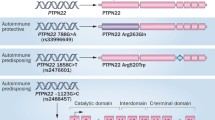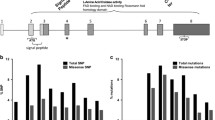Abstract
A SNP in the gene PTPN22 is associated with type 1 diabetes, rheumatoid arthritis, lupus, Graves thyroiditis, Addison disease and other autoimmune disorders. T cells from carriers of the predisposing allele produce less interleukin-2 upon TCR stimulation, and the encoded phosphatase has higher catalytic activity and is a more potent negative regulator of T lymphocyte activation. We conclude that the autoimmune-predisposing allele is a gain-of-function mutant.


Similar content being viewed by others
References
Mustelin, T., Vang, T. & Bottini, N. Nat. Rev. Immunol. 5, 43–67 (2005).
Tsui, H.W., Siminovitch, K.A., de Souza, L. & Tsui, F.W. Nat. Genet. 4, 124–129 (1993).
Majeti, R. et al. Cell 103, 1059–1069 (2000).
Hasegawa, K. et al. Science 303, 685–689 (2004).
Bottini, N. et al. Nat. Genet. 36, 337–338 (2004).
Smyth, D. et al. Diabetes 53, 3020–3023 (2004).
Ladner, M.B., Bottini, N., Valdes, A.M. & Noble, J.A. Hum. Immunol. 66, 60–64 (2005).
Begovich, A.B. et al. Am. J. Hum. Genet. 75, 330–337 (2004).
Siminovitch, K. Nat. Genet. 36, 1248–1249 (2004).
Gottlieb, P.A. & Eisenbarth, G.S. in The Molecular Pathology of Autoimmune Diseases 2nd edn. (A. Theofilopoulos & C.A. Bona, eds.) 588–613 (Taylor & Francis, New York, 2002).
Gjörloff-Wingren, A., Saxena, M., Williams, S., Hammi, D. & Mustelin, T. Eur. J. Immunol. 29, 3845–3854 (1999).
Salojin, K.V., Zhang, J., Madrenas, J. & Delovitch, T.L. Immunol. Today 19, 468–473 (1998).
Delovitch, T.L. & Singh, B. Immunity 7, 727–738 (1997).
Sakaguchi, N. et al. Nature 426, 454–460 (2003).
Vang, T. et al. Eur. J. Immunol. 34, 2191–2199 (2004).
Acknowledgements
We thank A. Cao for suggestions and P. Frongia, P. Pusceddu, M. Chessa and R. Riccardi for recruiting affected individuals and collecting blood samples. This work was supported by a fellowship from the Norwegian Cancer Society (to T.V.) and by grants from the Juvenile Diabetes Research Foundation (to N.B.), Telethon-JDRF (to F.C.) and the US National Institutes of Health (to T.M).
Author information
Authors and Affiliations
Corresponding author
Ethics declarations
Competing interests
The authors declare no competing financial interests.
Supplementary information
Supplementary Fig. 1
Analysis of T cell lineages and subpopulations in T1D children of RW or RR genotype. (PDF 151 kb)
Supplementary Fig. 2
The disease-associated LYP*W620 is a more potent inhibitor of early TCR signaling. (PDF 111 kb)
Rights and permissions
About this article
Cite this article
Vang, T., Congia, M., Macis, M. et al. Autoimmune-associated lymphoid tyrosine phosphatase is a gain-of-function variant. Nat Genet 37, 1317–1319 (2005). https://doi.org/10.1038/ng1673
Received:
Accepted:
Published:
Issue Date:
DOI: https://doi.org/10.1038/ng1673
- Springer Nature America, Inc.
This article is cited by
-
Exosome application in treatment and diagnosis of B-cell disorders: leukemias, multiple sclerosis, and arthritis rheumatoid
Cellular & Molecular Biology Letters (2022)
-
SH3-domain mutations selectively disrupt Csk homodimerization or PTPN22 binding
Scientific Reports (2022)
-
B Cell Aberrance in Lupus: the Ringleader and the Solution
Clinical Reviews in Allergy & Immunology (2022)
-
Polymorphisms of the genes CTLA4, PTPN22, CD40, and PPARG and their roles in Graves’ disease: susceptibility and clinical features
Endocrine (2021)
-
DNA hypermethylation of PTPN22 gene promoter in children and adolescents with Hashimoto thyroiditis
Journal of Endocrinological Investigation (2021)





